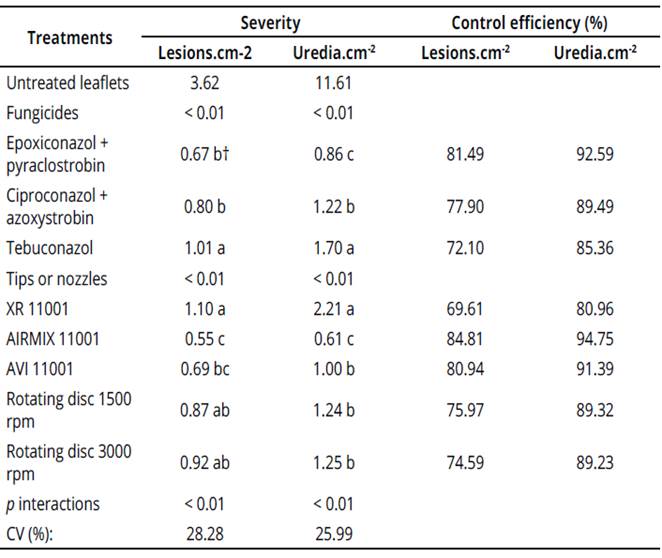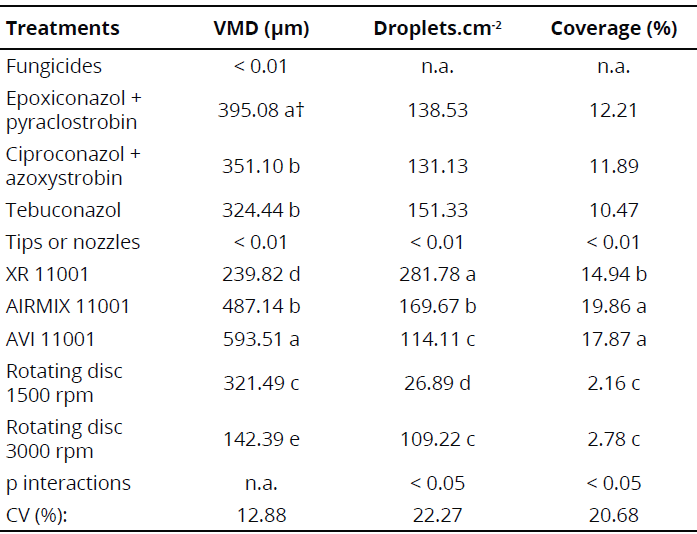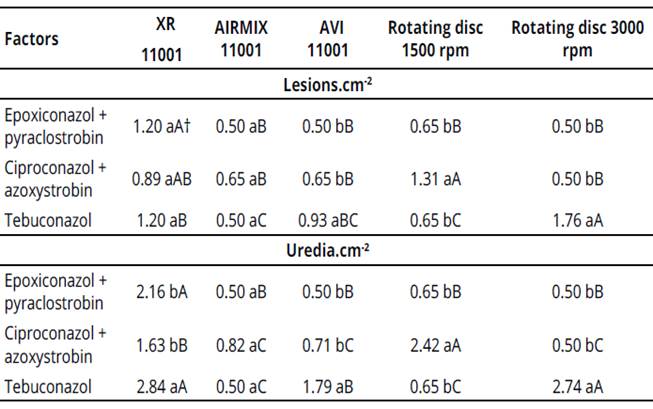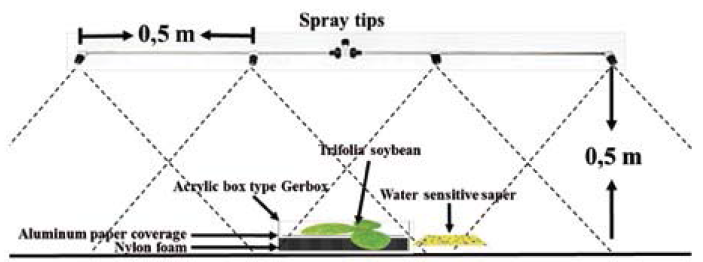Introduction
Asian soybean rust (Phakopsora pachyrhizi Syd. & P. Syd.) is currently the main biotic limitation of soybean (Glycine max (L.) Merril worldwide, being responsible for up to 90 % of losses caused (Yorinori et al., 2005) mainly due to early defoliation. Leaf reduction prevents complete seed formation with subsequent productivity reduction (Soares Rubin, Wielewicki & Ozelame, 2004). Moreover, when the disease presence is high, there are also a high number of uredia per unit area, therefore, greater interference on leaf metabolism and higher water loss; this in turn is reflected on leaflet durability (Garcés-Fiallos & Forcelini, 2011b).
Currently, due to lack of resistant commercial cultivars, the disease is controlled by the use of synthetic fungicides (Godoy & Canteri, 2004). Although most of them are efficient, for rust control these are not always satisfactory. According to Cunha, Moura, Silva Júnior, Zago & Juliatti (2008), this may be caused by inadequate product application, plus the fact that fungus behavior at early stages may interfere on its control. In fact, the disease may even begin at the lower third section during plant development, but the fungicides must overcome the barrier imposed by the leaf mass and promote an efficient coverage within the canopy (Garcés-Fiallos & Forcelini, 2013; Derksen, Zhu, Ozkan, Reding & Krause 2008).
In this sense, an efficient deposition of any fungicide on biological targets may depend on the correct choice of application tips or nozzles, technique and timing. Spray tips are the most important components of sprayers according to Sidahmed (1998), existing currently on the market a great variety with different technical and operational characteristics. Generally, tips that produce fine droplets, such as standard flat-jet tips are used (Debortoli, Tormen, Balardin, Favera, Stefanello, Pinto & Uebel, 2012). Owing to the fact that the droplet spectrum usually drifts, tips that produce larger droplets with air induction are preferred (Cunha, & Ruas 2006). However, establishing a droplet spectrum that will be used for a certain crop must consider its cultivation and environmental conditions in which pulverization or spraying will be carried out (Debortoli et al., 2012). Furthermore, other parameters as leaf area index (LAI) in soybean cultivars may influence droplet deposition and penetration into its canopy (Tormen, 2012).
Information such as droplet.cm2 required by a fungicide, spray volume to be applied, distance between nozzles in the spray bar, and the speed in which the equipment moves in the field are important parameters to be taken into account for an adequate selection of spray tips and nozzles (Boller, Hoffmann, Forcelini & Casa, 2008). However, there are few works where parameters attached to spray tips or nozzles have been assessed. Thus, variables related to application technology such as coverage and droplets on the target have to be taken into account to enhance chemical control of Asian soybean rust.
Considering the aforementioned, the aim of this study was to evaluate the chemical control of Asian soybean rust using different tips and spray nozzles under controlled conditions.
Material and methods
This study was conducted under greenhouse and growth chamber conditions at the Faculty of Agronomy and Veterinary Medicine, University of Passo Fundo (FAMV/UPF), Brazil.
Plant growth conditions
Glycine max cv. BRS 246 RR trifolia at phenological stage V2 (i.e. one unrolled trifoliate leaf), were grown in 10 L plastic pots and maintained in growth chambers (22 ± 2 °C and 12 hours photoperiod). Each trifolia (experimental unit) was placed inside an acrylic box (0.20 m x 0.20 m x 0.04 m), for a total of five boxes per treatment. Further, nylon foam (0.5 cm thick) and aluminum foil was placed inside these boxes, where trifolia petioles were introduced. Then, Murashige-Skoog-MS nutrient solution (1962) containing macronutrients, micronutrients and vitamins were added. Trifolia were maintained for 15 days under the conditions mentioned above.
Fungicides and spray tips or nozzles
In this study, the fungicides used were Opera® 0.5 L.ha1 (epoxiconazol + pyraclostrobin), Priori Xtra® 0.3 L.ha1 (ciproconazol + azoxystrobin) and Folicur® 0.5 L.ha1 (tebuconazol). These fungicides were sprayed at a height of 0.5 m with two knapsack sprayers (Figure 1), a pressurized with CO2 gas (drop generator in four spray tips spaced at 0.5 m from each other), and another rotating nozzle (drop generator using a rotating nozzle). Untreated trifolia were used as controls. Further, application rate was 100 L.ha1. The following tips or nozzles were used: TeeJet® XR 11001 (produces fine droplets - 200 kPa pressure), Airmix® 11001 (produces medium sized drops - 300 kPa pressure), and AVI® 11001 (produces large drops - 400 kPa pressure). Moreover, portable spray nozzles were operated at speeds of 1500 and 3000 rpm on its rotating disc.
Spray parameters
Water sensitive paper was placed next to each acrylic box (Figure 1), and images (1,200 dpi resolution) of these scanned papers were analyzed with the CIR 1.5® software (T & C s.r.l.). With this information, median volume diameter (MVD), droplet density (number of droplets.cm-2) and coverage (%) were determined. Furthermore, during fungicide application periods, wind speed ranged from 2.2 to 9 km.h1, air temperature fluctuated between 24.7 and 26.5 °C and relative humidity registered values between 50.0 to 68.6 %
Foliar inoculation and disease assessment
Trifolia were inoculated 24 hours after these were treated with fungicide. Uredospores of P. pachyrhizi were removed from naturally infected leaves collected in soybean plants at the FAMV/ UPF experimental field (approximately 200 g). These leaves were homogenized with sterile distilled water by hand shaking and then a drop of 80 % Tween was added. Trifolia were inoculated with a spore concentration adjusted to 2 x 104 uredospores.mL1, and remained in growth chambers for 30 days (under the conditions established above). Subsequently, number of lesions and uredia.cm2 were quantified in central leaflet using a stereomicroscope (ZEISS brand, 9 Stemi 2000-C model).
Experimental design and statistical analysis
The experiment was repeated twice under similar conditions, in a factorial completely randomized design with two factors: fungicides (3) and spray tips or nozzles (5). The control was not used in the analysis.
Fungicide efficiency assessment was analyzed by comparison of treated and untreated trifolia. After verifying variance homogeneity (Bartlett's test) and normality of residues (Shapiro-Wilks test), data were subject to analysis of variance. When the assumptions were satisfied, data was analyzed with an ANOVA. Tukey test (p < .05 and p < .01) was used for separation of means, and all variables evaluated were correlated (Pearson: r). The analyses were carried out with the GraphPad® Prism 5 statistical software.
Results
The maximum severity observed in untreated leaflets was 3.62 lesions.cm2 and 11.61 uredia. cm2 (Table 1). Moreover, number of lesions and uredia.cm2 in treated leaflets were four and ninefold higher, respectively, when compared to non-treated leaflets. In general, a lower number of lesions and uredia.cm2 were observed in leaflets treated with the two mixtures, with an average control efficiency of 85 %. Furthermore, lower number of lesions and uredia.cm2 (Table 1) were recorded in leaflets sprayed with the AIRMIX 11001 tip (Table 2).
Table 1 Asian soybean rust severity (number of lesions and uredia.cm-2) and control efficiency (%) on G.max cv. BRS 246 leaflets sprayed with fungicides and tips or nozzles.

t Means followed by different letters within a column are significantly different (p < .01, Tukeytest) within each factor (fungicides and tips or nozzles).
Table 2 Volume median diameter (VMD), number of droplets.cm-2 and coverage (%) on water sensitive paper placed next to leaflets of G. max cv. BRS 246 sprayed with fungicides and tips or nozzles.

t Means followed by different letters within a column are significantly different (p < .05 and p < .01, Tukey test) within each factor (fungicides and tips or nozzles).
Volume median diameter (VMD) in leaflets sprayed with the fungicides azoxystrobin + epoxiconazole, and tebuconazole was lower in comparison to those treated with the other mixture (Table 2). A biological relationship between this parameter and disease severity was not observed.
All tips used generated larger droplets than those described by the manufacturer (Table 2). For instance, the AIRMIX 11001 tip generated mean-sized droplets of 201-400 μπι. However, a VMD generated by this tip was 487.14 μ111, fitting into the category of large droplets (> 401 μ111). On the other hand, the portable spray nozzles generated fine (3000 rpm) and medium-sized (1500 rpm) droplets.
In general, the analysis of significant interactions showed a similar behavior of number of lesions and uredia.cm2 among the fungicides inside each tip or nozzle (Table 3). However, some exceptions were found. In the first case, number of uredia.cm2 was lower using the XR 11001 tip and mixtures of fungicides. In the second case, the number of lesions.cm2 was lower using tebuconazol with AIRMIX 11001 and AVI 11001 tips, as well as with the portable spray nozzle at 1500 rpm.
Table 3 Significant interactions among fungicides (factor A) and types of tips or nozzles (factor B) regarding number of lesions and uredia.cm-2 of Asian soybean rust on G. max cv. BRS 246 leaflets sprayed with fungicides using different types of tips or nozzles.

t Means followed by the same lower- and upper-case letter in the row and column, respectively, do not differ statistically(p < .01, Tukeytest).
Furthermore, in the significant interactions analysis corresponding to spray parameters (Table 4), number of droplets.cm2 was higher with the epoxiconazol + pyraclostrobin and tebuconazole fungicides using the AIRMIX 11001 tip. In addition, a higher number of droplets.cm2 was observed with the use of a XR 11001 tip and all fungicides. Regarding coverage, the use of all tips and fungicides generated higher coverage, except with the XR 11001 tip and tebuconazol fungicide.
Table 4 Significant interactions among fungicides (factor A) and types of tips or nozzles (factor B) regarding number of droplets.cm-2 and coverage (%) on water sensitive paper placed next to leaflets of G. max cv. BRS 246 sprayed with different fungicides using different types of tips or nozzles.

t Means followed by the same lower- and upper-case letter in the row and column, respectively, do not differ statistically(p < .05, Tukeytest).
Asian soybean rust severity was not correlated with any of the spray parameters (Table 4). In contrast, the number of lesions and uredia.cm-2 (r = .91) were correlated positively. Furthermore, coverage was also positively correlated with VMD (r = .72) and number of droplets.cm2 (r = .57) (Table 5).
Table 5 Pearson's correlation (r) among Asian soybean rust severity (lesions and uredia.cm-2) and spray parameters (VMD, droplets.cm-2 and coverage) obtained on G. max cv. BRS 246 leaflets and on water sensitive paper placed next to leaflets this same cultivar, respectively.

Significant positive correlations (*: p < .05; ***: p < .001)
Discussion
Regarding maximum severity observed in untreated leaflets the values obtained were 3.62 lesions.cm2 and 11.61 uredia.cm2. In this sense, Garcés-Fiallos & Reis (2012) registered 6.71 lesions.cm2 and 11.69 uredia.cm2 on leaflets of soybean plants cv. Coodetec 214 RR inoculated with a spore concentration adjusted to 2 x 104 uredospores mL1 of P. pachyrhizi. This suggests that differences are probably attributed to experimental conditions, as the fungal concentration used was sufficient to generate intense symptoms on leaflets.
When comparing the number of lesions and uredia.cm2 in untreated and treated leaflets, these last were four and nine-fold higher, respectively. In fact, the efficiency of fungicides has also been demonstrated by other authors as Levy (2005), and there is a positive association between uredia and lesions.cm2 (Garcés-Fiallos & Reis, 2012). The use of fungicides in soybean leaflets promotes a higher leaf area duration (Garcés-Fiallos & Forcelini, 2011b) and an increasing in grain yield (Cunha & Ruas, 2006; Cunha et al., 2008; Henry, Johnson & Wise, 2011; Levy, 2005).
The use of fungicide mixtures may be more effective in reducing a disease (Garcés-Fiallos & Forcelini, 2013; Godoy & Canteri, 2004; Godoy, Flausino, Santos & Del Ponte, 2009). For example, the use of fungicide mixtures including epoxiconazol + pyraclostrobin, in addition to increasing the disease control efficiency under field conditions in up to 69% (Garcés-Fiallos & Forcelini, 2011a), it also provides a Lower Area Under the Disease Progress Curve (AUDPC) and defoliation, as well as higher grain yield (Garcés-Fiallos & Forcelini, 2011b). Authors as Garcés-Fiallos and Forcelini (2013), stated that there is a reduction in the sensitivity of causal agent of rust to triazols, as has been observed in several regions of Brazil.
VMD in leaflets sprayed with azoxystrobin, epoxiconazole and tebuconazole were lower in comparison to those treated with the other mixtures. A biological relationship between this parameter and the severity disease was not observed. Although the number of droplets.cm2 did not vary among fungicides, difference in VMD may be due to product density. According to fungicide fabricants, mixtures of ciproconazol + azoxystrobin and epoxiconazol + pyraclostrobin show an average density of 60 and 85 droplets. cm2, respectively. There is however, no information about the fungicide tebuconazole.
Lower number of lesions and uredia.cm2 were registered in leaflets sprayed with the AIRMIX 11001 tip. The droplet spectrum is important during fungicide application, due to closure of soybean leaf cover throughout the crop. In this regard, fine droplet spectrum provides an efficient deposition, control of the Asian soybean rust, and productivity, regardless of the soybean cultivar assessed (Debortoli et al., 2012). Such droplets have a higher fungicide absorption rate (Lenz, Balardin, Minuzzi, Tormen & Marques, 2011), and higher penetration on soybean plant canopy (Román, Cortez, Ferreira & Oliveira, 2009). According to Debortoli et al., (2012), a fine droplet spectrum (<200 μm) gives efficient results in terms of droplet deposition. However, our results show that Asian soybean rust was more efficiently controlled using tips with higher VMD and < 400 μm drops, i.e. medium and large-sized drops. The use of fine droplets to reach the lower thirds of the plant should be avoided, unless the air supply is able to help droplets move deeper into these thirds (Derksen et al., 2008). In this case, nozzles that generate medium droplets may promote adequate droplet coverage at the upper and middle thirds of soybean plants (Tormen, 2012). Perhaps, the use of large drops may be efficiently used in applications before the closure of the space between rows, as they will allow distribute the fungicide at the lower parts of the plant, besides reaching the disease at the early. Our results show that Asian soybean rust control as well as number of droplets.cm2 and coverage depends on the interactions among fungicides and types of tips or nozzles. This denotes the importance of the correct choice of each factor when spraying.
Coverage was also positively correlated with VMD and number of droplets.cm2. Thus, the uniform coverage assumes a satisfactory distribution of pulverized or sprayed liquid characterized by low coefficients of variation of surface volumetric distribution regarding tip sets (Cunha & Silva, 2010). Tips or nozzles with higher density provide greater leaf area coverage and subsequently, efficient absorption (Lenz et al., 2011). However, our results showed that for example, tips such as XR 11001 that generate higher droplet density did not efficiently control the Asian soybean rust disease.
Conclusion
Lower number of lesions and uredia.cm2 were observed in leaflets treated with the two fungicide mixtures applied with an AIRMIX 11001 tip. A lower VMD was found in leaflets sprayed with fungicides azoxystrobin + epoxiconazol and tebuconazol, when compared to the leaflets treated with the other mixtures. The Asian soybean rust control as well as the number of droplets.cm2 and coverage appears to depend on the interactions among fungicides and the type of tips or nozzles used. Coverage was positively correlated with VMD and number of droplets.cm2.
















